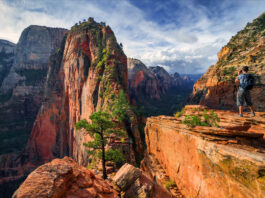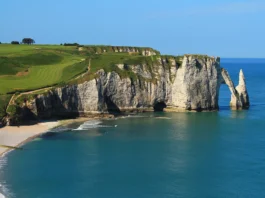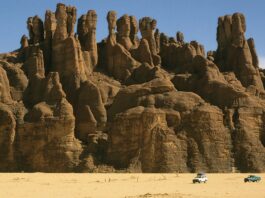The Blue Hole in Gozo is a captivating natural wonder that holds both beauty and ecological significance. Located off the coast of Dwejra Bay on the island of Gozo, which is part of the Maltese archipelago in the Mediterranean Sea, the Blue Hole is renowned for its breathtaking underwater scenery and unique geological formations.

Location:
Situated near the iconic Azure Window, a natural limestone arch that sadly collapsed in 2017, the Blue Hole is a popular diving and snorkeling site. It is accessible from the shore and offers divers a mesmerizing underwater experience. The hole itself is a vertical chimney-like structure, leading divers through a natural tunnel that opens up to the open sea. The surrounding cliffs and rock formations add to the picturesque setting of this natural attraction.

Significance:
The Blue Hole is not only a favorite among recreational divers but also holds ecological importance. Its crystal-clear waters are home to a diverse range of marine life, including various species of fish, crustaceans, and vibrant coral formations. The hole itself provides a unique habitat for several species adapted to the specific conditions of this underwater environment.
In addition to its ecological significance, the Blue Hole is part of the Dwejra Marine Conservation Area, emphasizing the commitment to preserving the natural beauty and biodiversity of the area. The site’s popularity also contributes to Gozo’s tourism industry, attracting visitors from around the world who are eager to explore its underwater wonders.
Despite the tragic loss of the Azure Window, the Blue Hole remains a testament to the geological and ecological wonders found in this part of the Mediterranean. Its continued allure speaks to the enduring appeal of nature’s marvels and the importance of responsible tourism and conservation efforts to protect such fragile ecosystems.
Contents
Geological Formation of The Blue Hole, Gozo

The Blue Hole in Gozo is a geological marvel formed through a combination of natural processes over an extended period. Its unique structure can be attributed to the dissolution of limestone, a process known as karstification, which is common in areas with soluble bedrock.
- Karstification: The bedrock of the Maltese islands, including Gozo, is primarily composed of limestone. Limestone is susceptible to dissolution by slightly acidic rainwater, a process that forms cavities and conduits in the rock over time. As rainwater percolates through the limestone, it dissolves minerals, enlarging fractures and creating underground channels.
- Collapse Feature: The Blue Hole is essentially a collapsed cave or sinkhole that formed when the roof of an underground cavern weakened and eventually collapsed. The collapsed portion, now open to the surface, created the circular opening known as the Blue Hole. This process of collapse is a characteristic feature of karst landscapes.
- Tunnel Formation: The Blue Hole is connected to the inland sea through a natural tunnel or chimney. This tunnel was also formed through the dissolution of limestone, creating a passage that divers can traverse to access the open sea. The tunnel adds an extra layer of intrigue to the geological features of the Blue Hole.
Geological Features Surrounding the Area:
- Cliffs and Coastal Formations: The Blue Hole is surrounded by rugged coastal cliffs, which were once part of the larger limestone formation. These cliffs contribute to the dramatic landscape and provide a stunning backdrop to the Blue Hole. The constant erosive forces of the sea have shaped these cliffs over time.
- Inland Sea: The Blue Hole is connected to the Inland Sea, a shallow, saltwater lagoon enclosed by cliffs. The Inland Sea itself is a collapsed cave system, similar to the Blue Hole but on a larger scale. It is a unique coastal lagoon with calm waters, making it a popular spot for boat trips and swimming.
- Remnants of the Azure Window: Although the Azure Window, a natural limestone arch, collapsed in 2017, the remnants of its pillars and rocks are still present in the vicinity. These remnants add historical and geological interest to the area, serving as a reminder of the dynamic and ever-changing nature of the landscape.
The geological features surrounding the Blue Hole collectively create a captivating and dynamic environment. The interplay of limestone dissolution, collapse features, and coastal formations contributes to the unique and picturesque nature of this underwater wonder in Gozo.
Underwater Landscape

The underwater landscape of the Blue Hole in Gozo is a captivating realm, drawing divers and snorkelers from around the world. The crystal-clear waters, coupled with unique geological features, contribute to an awe-inspiring underwater environment.
- Blue Hole Arch and Chimney: The Blue Hole is characterized by a distinctive arch and chimney formation. The underwater arch, a natural bridge-like structure, is a stunning feature that divers can swim through. This creates a sense of underwater exploration and adds an element of adventure to the experience. The chimney, or vertical tunnel, provides a passage from the inland sea to the open sea and is a focal point for divers navigating the site.
- Corals and Marine Life: The Blue Hole is surrounded by vibrant and diverse marine life. The clear waters allow for excellent visibility, offering a glimpse into a thriving ecosystem. Coral formations adorn the underwater landscape, with colorful soft and hard corals providing a habitat for various marine species. Fish, including damselfish, groupers, and wrasses, can be spotted swimming among the corals.
- Sea Grass Beds and Seafloor: The seabed around the Blue Hole often features patches of seagrass, providing a crucial habitat for juvenile fish and other marine organisms. The presence of seagrass beds adds to the overall biodiversity of the area and contributes to the ecological balance of the underwater ecosystem.
- Caves and Overhangs: Beyond the arch and chimney, the Blue Hole’s underwater landscape includes caves and overhangs formed by the dissolution of limestone. These geological formations create intricate underwater spaces for exploration. Divers can navigate through these caves, discovering hidden nooks and crannies that harbor marine life and contribute to the area’s mystique.
- Biodiversity: The Blue Hole supports a rich diversity of marine species, ranging from smaller invertebrates to larger fish. Sea urchins, nudibranchs, and crustaceans can be found in and around the rocky formations, while schools of fish add movement and vitality to the underwater scene.
Conservation Considerations:
Due to its popularity, the Blue Hole is subject to environmental pressures. Responsible diving practices and conservation efforts are crucial to preserving the delicate balance of the underwater ecosystem. Divers are encouraged to follow guidelines to minimize their impact on the marine environment and contribute to the long-term sustainability of this natural wonder.
In summary, the underwater landscape of the Blue Hole in Gozo is a testament to the beauty and complexity of the Mediterranean marine environment. From the striking arch and chimney formations to the diverse marine life and coral gardens, the Blue Hole offers a truly immersive and unforgettable underwater experience.
Tourism and Accessibility of The Blue Hole, Gozo

The Blue Hole in Gozo has become a major attraction for tourists, particularly those interested in diving and snorkeling. The site’s accessibility, both from land and sea, contributes to its popularity among visitors seeking to explore the underwater wonders of the Mediterranean.
- Access Points: The Blue Hole is easily accessible from the shore, with a designated entry point for divers and snorkelers. A set of stairs leading down to the water provides a convenient access point, allowing visitors to explore the site without the need for a boat. This accessibility enhances the appeal of the Blue Hole for both experienced divers and those looking for a more casual snorkeling experience.
- Diving Centers and Services: Surrounding areas, particularly in Dwejra Bay, are equipped with diving centers and services. These facilities cater to divers of all skill levels, offering equipment rental, guided dives, and training for beginners. Divers can explore not only the Blue Hole but also nearby dive sites, contributing to the overall diving tourism in the region.
- Boat Trips: Boat trips are another popular way to experience the Blue Hole. Visitors can take boat tours from various points along the Gozo coast, allowing them to reach the Blue Hole and other nearby attractions. Boat trips often include stops at other scenic spots, providing a comprehensive exploration of the coastal beauty of Gozo.
- Tourist Infrastructure: The tourism infrastructure in the surrounding areas caters to the needs of visitors. Facilities such as parking, restrooms, and information centers are available to enhance the overall tourist experience. The proximity of the Blue Hole to other attractions, such as the Inland Sea and the remnants of the Azure Window, adds to the appeal for tourists looking to explore the broader natural beauty of the region.
- Conservation and Responsible Tourism: With the increase in tourism, there is a growing emphasis on responsible tourism and conservation efforts. Local authorities and environmental organizations work to educate visitors about the importance of preserving the fragile marine ecosystem. Guidelines for responsible diving and snorkeling are often provided to minimize the impact on the underwater environment.
- Accessibility for All: The Blue Hole caters to a diverse range of visitors, including those with varying levels of physical abilities. The accessibility from the shore ensures that people of different ages and physical conditions can enjoy the beauty of the site, whether they are diving, snorkeling, or simply admiring the view from the water’s edge.
The combination of accessibility, tourist infrastructure, and the unique underwater landscape makes the Blue Hole a sought-after destination for both local and international visitors. However, it is crucial for the continued preservation of this natural wonder that tourism is managed responsibly, with a focus on conservation and environmental protection.






